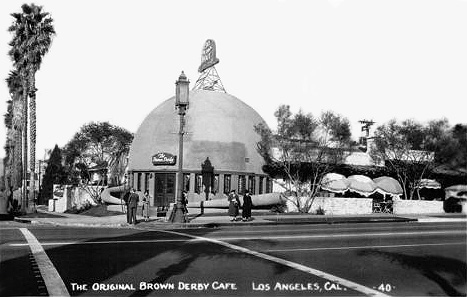In an earlier post I wrote about buildings shaped like what they sell – known as “ducks.” Usually they sold simple foods rather than entire meals. They were often located on busy roads where it wasn’t easy to get cars to stop. But proprietors realized that even the most humble shed, if masquerading as a giant dog or coffee pot, just might get speeding motorists to stop for closer examination.
Ducks, which became popular in the 1930s, could be found all over the country but their birthplace is usually cited as Southern California, the land of fantasy and car culture.
The slogan “eat in the hat” was, in fact, created in Los Angeles for the Brown Derby restaurant that opened in 1926 on Wilshire Blvd, shown above a few years later after it enlarged and added a patio.
To be considered a genuine duck, the Brown Derby should have been selling hats, but it was a restaurant, and one with a standard menu rather than just grab-and-go food. Its fame derived from its successful courtship of gossip columnists and film stars.
 Copying, I am convinced, is one of the most common business tactics. Eating places love to borrow a little bit of the glamour of far-off restaurants that have achieved fame. As Los Angeles’ Brown Derby became famous, taverns and eateries across the land adopted Brown Derby, Green Derby, and related names. As shown in the images that follow, some also created a variety of hat-shaped buildings, signs, and menus.
Copying, I am convinced, is one of the most common business tactics. Eating places love to borrow a little bit of the glamour of far-off restaurants that have achieved fame. As Los Angeles’ Brown Derby became famous, taverns and eateries across the land adopted Brown Derby, Green Derby, and related names. As shown in the images that follow, some also created a variety of hat-shaped buildings, signs, and menus.
 Brown Derby Drive-in, Southern CA – Something went terribly wrong with the shape of this derby.
Brown Derby Drive-in, Southern CA – Something went terribly wrong with the shape of this derby.
 Brown Derby, Tyler TX – Ditto.
Brown Derby, Tyler TX – Ditto.
 Brown Derby, Evansville IN – The Hat had loomed impressively larger atop an earlier, one-story building. As humorist S. J. Perelman wrote in 1936, “. . . the flood waters of the Ohio River weren’t far away, but the Brown Derby went unscathed. Such is the irony of nature.”
Brown Derby, Evansville IN – The Hat had loomed impressively larger atop an earlier, one-story building. As humorist S. J. Perelman wrote in 1936, “. . . the flood waters of the Ohio River weren’t far away, but the Brown Derby went unscathed. Such is the irony of nature.”
 Brown Derby, Olympia WA – Menu on which a waffle with “wild blackberry syrup” was 40 cents.
Brown Derby, Olympia WA – Menu on which a waffle with “wild blackberry syrup” was 40 cents.
 Miner’s Hat, Kellogg ID – Why stick to derbies? This Hat had odd hours, from 10:00 A.M. to 1:00 A.M., possibly to mesh with work shifts of area miners.
Miner’s Hat, Kellogg ID – Why stick to derbies? This Hat had odd hours, from 10:00 A.M. to 1:00 A.M., possibly to mesh with work shifts of area miners.
 Hat-O-Mat, between Warren and Youngstown OH – Maybe it was too hard to build a derby shaped drive-in? A 1950 advertisement in the Cleveland Plain Dealer sought franchisees for the Hat-O-Mat’s unnamed “new idea in feeding the public.”
Hat-O-Mat, between Warren and Youngstown OH – Maybe it was too hard to build a derby shaped drive-in? A 1950 advertisement in the Cleveland Plain Dealer sought franchisees for the Hat-O-Mat’s unnamed “new idea in feeding the public.”
 El Sombrero Drive-In, Albuquerque NM – A sombrero on top just in case people didn’t realize this was a restaurant serving Mexican food. A sombrero is without doubt one of the most hackneyed of restaurant symbols.
El Sombrero Drive-In, Albuquerque NM – A sombrero on top just in case people didn’t realize this was a restaurant serving Mexican food. A sombrero is without doubt one of the most hackneyed of restaurant symbols.
© Jan Whitaker, 2018


















 It's great to hear from readers and I take time to answer queries. I can't always find what you are looking for, but I do appreciate getting thank yous no matter what the outcome.
It's great to hear from readers and I take time to answer queries. I can't always find what you are looking for, but I do appreciate getting thank yous no matter what the outcome.


